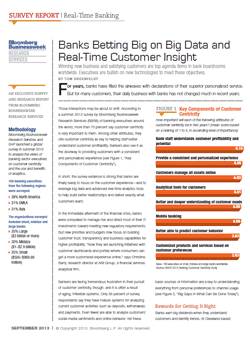
Kundenzentrierung im Banking
Die Notwendigkeit für mehr Kundenorientierung steht im Mittelpunkt der Überzeugungen der meisten Bankführungskräfte. Neue Technologien können hier wirksame Hilfe leisten.
Banks aren’t very good at knowing what they’re customers do when they are doing business with the bank – and they are worse at tracking what those customers do when they are not interacting with the bank.
The rewards for getting it right are huge: in Bloomberg’s research, the National Bank of Canada went from having 1.9 products per customer to 4.5 products per customer by using CRM to track their customers, rather than their products.
The most common difficulty is the volume of data that overwhelms bank systems. Partly this is because those systems are old. Partly it’s because the systems were built to process transactions, not provide customer data. Partly it’s not a bank problem at all: the glut of customer data is a problem shared by all customer-facing companies. We are accustomed to thinking of “big data” only as an opportunity to learn more, but there is a problem in separating the signal from the noise, and another problem in acting on those signals. Most of what we learn isn’t relevant. A lot more might be relevant, but we don’t know how to act on it; some is definitely relevant, and we know what we’d like to do, but not how to do it.
On the other hand, some pathfinder banks are using their customer knowledge to drive strategy and make gains. Wells Fargo pools data collected from text banking, its mobile site and smartphone apps to guide innovation. In Australia, Commonwealth Bank personalises its web site to customers depending on how it tracks their activity.
What these two projects – and other successes – have in common is their commitment to pooling data from multiple sources, if it helps to answer a problem. The customer doesn’t understand why the deposit account goes through a different system to the mortgage, and the mortgage, or that their contacts made through the internet are not analysed in the same process as contact made in the branch.
Technology will go some ways to solving this problem. We works with many retail banks to create a common platform for their business, one that allows them to look at their customers as people, with many different needs. It allows banks to stop thinking about “channels” – just different endpoints that customers use. It can help to collect that data and provide the insight to prioritise innovation that customers value.
Big Data solutions alone will not solve the problem; they necessary, but not sufficient. Technology is the start, but this survey shows how long the journey will be.
Quelle: SAP
Eine Zusammenfassung der Studie „Customer Centricity in Banking“ kann hier direkt heruntergeladen werden.


